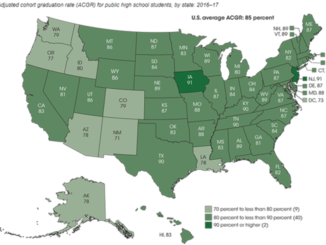
A landmark peer review recently released by Bellwether Education Partners and the Collaborative for Student Success analyzed the quality of the 17 state education plans already submitted to the U.S. Department of Education under the Every Student Succeeds Act (ESSA).
Unfortunately, their findings revealed a major deficit in every one of them.
The study enlisted more than 30 bipartisan state and national education policy experts — including representatives from the Reagan, Bush, and Obama administrations and the Trump transition team — to grade the plans against a set of nine categories meant to clarify each state’s proposed accountability system and how it will undertake important tasks like identifying and supporting low-performing schools and laying out a clear vision for educating its students.
For every category, the study awarded at least one state a perfect score on a scale of 1 to 5 — every category, that is, except one. The panel concluded that not one of the 17 plans adequately addresses how it will provide a high-quality education for all students.
In other words, not a single state plan excels in ensuring education equity for students of color, English language learners, low-income children, and other marginalized groups.
Education has long been the great equalizer in our society, providing a bridge from poverty to prosperity across generations. As America’s minority population continues to explode, ensuring a quality education for every student is more important than ever. According to Pew Research, more than 50 percent of children born in America in 2015 were racial or ethnic minorities — but, unfortunately, study after study demonstrates persistent educational achievement gaps along racial lines.
Take, for example, a recent Brookings Institution study that highlights the racial gap in SAT scores. Across all groups, the average SAT math score is 511 out of a possible 800. Disturbingly, black students average just a 428, with Hispanics scoring only slightly higher, at 457. Both groups trail far behind their white and Asian counterparts, who score an average of 534 and 598, respectively.
Race-based achievement gaps as wide as these demand action. This is not an issue of aptitude, but of access to sufficient resources and opportunities.
At its best, ESSA represents the potential for each state to forge a bright future for all its students and to experiment with new and innovative ideas that might eventually transform the way we approach education across the country. But if our state plans fail to effectively address ways of ensuring a high-quality education for students who need the most help, we risk creating a perpetual second-class citizenship.
America’s achievement gaps will not close overnight, but every state should have a robust plan to address them. Right now, we don’t even have one.
Here’s the good news: There’s still time to solve this. While some state plans have been approved, others are still under review. None, however, have been implemented, so states have an opportunity to continue to focus on closing achievement gaps as they implement their plans on the ground — in districts, schools, and classrooms.
Of the state plans submitted, New Mexico scored the highest in this crucial category. All states should consult New Mexico’s plan, and then write a plan that’s right for their state to close these gaps — one that goes further.
The Collaborative for Student Success and Bellwether will reconvene their experts to review the plans most recently submitted to the DOE. These second-round states would do well to learn from the areas of improvement identified in the first plans and, as they work with the department to secure approval, ensure that any proposed measures for guaranteeing the success of all students are clearly articulated.
Lower-income, marginalized, and at-risk students need focused and sustained resources aimed at closing achievement gaps and ensuring education equity. Only then will the promise of ESSA be fully realized for every student, in every classroom, and in every state across the nation.
Dr. Andrea Ramirez is the executive director of the Faith and Education Coalition, an initiative of the National Hispanic Christian Leadership Conference. Its 2,568 members, representing almost 3,000 local churches, are united in support of a quality education for all students regardless of ZIP code, ethnicity, or income.



